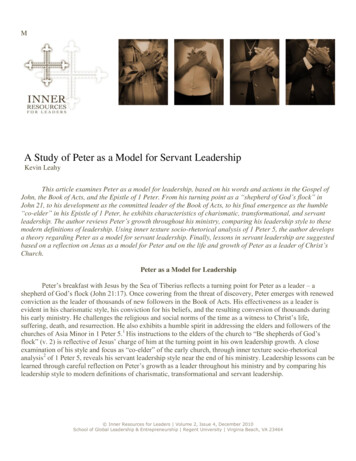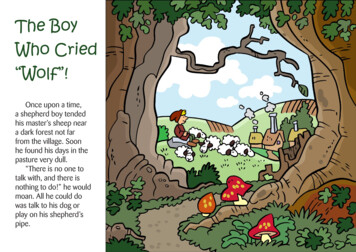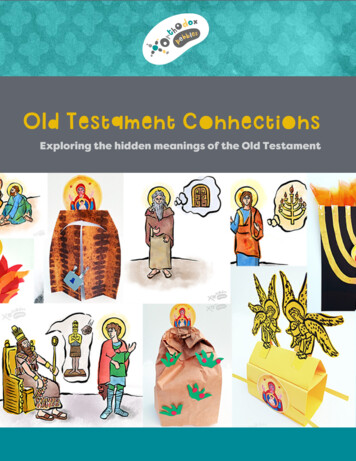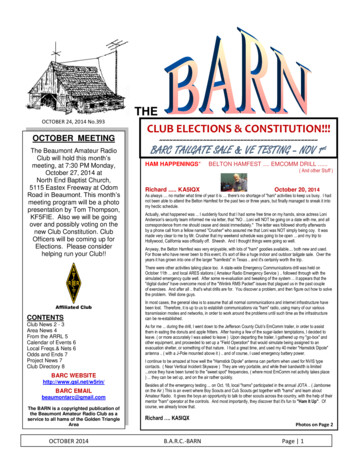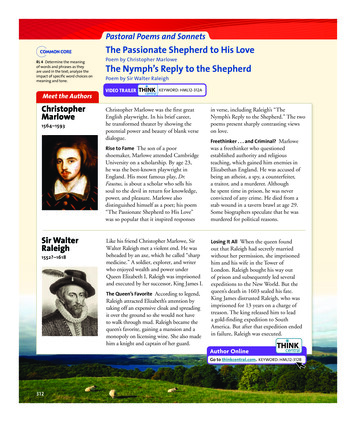
Transcription
Pastoral Poems and SonnetsThe Passionate Shepherd to His LoveRL 4 Determine the meaningof words and phrases as theyare used in the text; analyze theimpact of specific word choices onmeaning and tone.Poem by Christopher MarloweThe Nymph’s Reply to the ShepherdPoem by Sir Walter RaleighVIDEO TRAILERKEYWORD: HML12-312AMeet the AuthorsChristopherMarlowe1564–1593Christopher Marlowe was the first greatEnglish playwright. In his brief career,he transformed theater by showing thepotential power and beauty of blank versedialogue.Rise to Fame The son of a poorshoemaker, Marlowe attended CambridgeUniversity on a scholarship. By age 23,he was the best-known playwright inEngland. His most famous play, Dr.Faustus, is about a scholar who sells hissoul to the devil in return for knowledge,power, and pleasure. Marlowe alsodistinguished himself as a poet; his poem“The Passionate Shepherd to His Love”was so popular that it inspired responsesSir WalterRaleighLike his friend Christopher Marlowe, SirWalter Raleigh met a violent end. He wasbeheaded by an axe, which he called “sharpmedicine.” A soldier, explorer, and writerwho enjoyed wealth and power underQueen Elizabeth I, Raleigh was imprisonedand executed by her successor, King James I.1552?–1618The Queen’s Favorite According to legend,Raleigh attracted Elizabeth’s attention bytaking off an expensive cloak and spreadingit over the ground so she would not haveto walk through mud. Raleigh became thequeen’s favorite, gaining a mansion and amonopoly on licensing wine. She also madehim a knight and captain of her guard.in verse, including Raleigh’s “TheNymph’s Reply to the Shepherd.” The twopoems present sharply contrasting viewson love.Freethinker . . . and Criminal? Marlowewas a freethinker who questionedestablished authority and religiousteaching, which gained him enemies inElizabethan England. He was accused ofbeing an atheist, a spy, a counterfeiter,a traitor, and a murderer. Althoughhe spent time in prison, he was neverconvicted of any crime. He died from astab wound in a tavern brawl at age 29.Some biographers speculate that he wasmurdered for political reasons.Losing It All When the queen foundout that Raleigh had secretly marriedwithout her permission, she imprisonedhim and his wife in the Tower ofLondon. Raleigh bought his way outof prison and subsequently led severalexpeditions to the New World. But thequeen’s death in 1603 sealed his fate.King James distrusted Raleigh, who wasimprisoned for 13 years on a charge oftreason. The king released him to leada gold-finding expedition to SouthAmerica. But after that expedition endedin failure, Raleigh was executed.Author OnlineGo to thinkcentral.com. KEYWORD: HML12-312B312NA L12PE-u02s11-brShep.indd31211/24/1011:44:33 AM
poetic form: pastoralA pastoral is a poem that presents shepherds in idealized ruralsettings. Renaissance poets like Marlowe and Raleigh used thepastoral form to express their feelings and thoughts about loveand other subjects. Shepherds in pastorals tend to use courtlyspeech. The poems usually have metrical patterns and rhymeschemes that help give them a musical or songlike quality.The imagery derives from commonplace country settings, asthe following lines suggest:And we will sit upon the rocks,Seeing the shepherds feed their flocks.As you read these poems, look for details of pastoral life and forthe use of nature imagery to convey emotions and ideas.reading skill: compare speakersThe speaker in a poem is the voice that addresses the reader,much like the narrator in a work of fiction. Poets use thespeakers they create to express ideas or tell a story froma specific point of view. The speaker and the poet are notnecessarily identical, even when the words I and me are used.The speakers in the following poems—the shepherd andthe nymph—express very different attitudes about the topicof love. To identify the differences, considerIs passionoverrated?Throughout the ages, writers havecomposed poems and songs describingthe ardor of new love. But have peopleplaced too much emphasis on passionin romantic love? Are other aspects oflove—such as friendship, respect, andtrust—more important?QUICKWRITE Make a list of qualitiesthat you think are important in aromantic relationship. Rank the items,and then write a paragraph explainingthe reasons for your ranking. whom the speaker is addressing the speaker’s choice of words evidence of the speaker’s attitude toward the poem’s subjectAs you read both poems, use a chart like the one shown tomake notes on the speakers’ differing attitudes toward love.Look for specific words and phrases that indicate their feelings.Shepherd’s LineNymph’s Reply“I will make thee beds of roses”“flowers do fade”Complete the activities in your Reader/Writer Notebook.313NA L12PE-u02s11-brShep.indd31311/24/1011:44:47 AM
The PassionateShepherd to His LoveChristopher MarloweCome live with me and be my love,And we will all the pleasures proveThat valleys, groves, hills, and fields,Woods, or steepy mountain yields.51015202 prove: experience.And we will sit upon the rocks,Seeing the shepherds feed their flocks,By shallow rivers to whose fallsMelodious birds sing madrigals.8 madrigals: songs of a type popularduring the Renaissance.And I will make thee beds of rosesAnd a thousand fragrant posies,A cap of flowers, and a kirtleEmbroidered all with leaves of myrtle;A gown made of the finest woolWhich from our pretty lambs we pull;Fair lined slippers for the cold,With buckles of the purest gold;11 kirtle: skirt or dress.aunit 2: the english renaissanceNA L12PE-u02s11-Shepar.indd314What characteristics of pastoralpoems do you find in lines 9–14?A belt of straw and ivy buds,With coral clasps and amber studs:And if these pleasures may thee move,Come live with me, and be my love.The shepherds’ swains shall dance and singFor thy delight each May morning:If these delights thy mind may move,Then live with me and be my love.314a PASTORAL21 swains: companions.Working Wool (1500). From the series of Noblemen in the Country. Loire Valley workshops.Louvre, Paris. Réunion des Musées Nationaux/Art Resource, New York.11/24/1011:57:29 AM
NA L12PE-u02s11-Shepar.indd31511/24/1011:57:34 AM
The Nymph’sReply to the ShepherdSir Walter RaleighIf all the world and love were young,And truth in every shepherd’s tongue,These pretty pleasures might me moveTo live with thee and be thy love.5101520Time drives the flocks from field to foldWhen rivers rage and rocks grow cold,And Philomel becometh dumb;The rest complains of cares to come.5 fold: a pen for animals, especiallysheep.The flowers do fade, and wanton fieldsTo wayward winter reckoning yields;A honey tongue, a heart of gall,Is fancy’s spring, but sorrow’s fall.9 wanton: here, producing abundantcrops; luxuriant.Thy gowns, thy shoes, thy beds of roses,Thy cap, thy kirtle, and thy posiesSoon break, soon wither, soon forgotten—In folly ripe, in reason rotten. bThy belt of straw and ivy buds,Thy coral clasps and amber studs,All these in me no means can moveTo come to thee and be thy love.But could youth last and love still breed,Had joys no date nor age no need,Then these delights my mind might moveTo live with thee and be thy love.3167 Philomel: the nightingale; dumb:silent.b COMPARE SPEAKERSReread lines 13–16. How doesthe nymph directly refute theshepherd’s promises?22 date: ending.unit 2: the english renaissanceNA L12PE-u02s11-Shepar.indd31611/24/1011:57:40 AM
After ReadingComprehension1. Recall What gifts does the shepherd offer his beloved in Marlowe’s poem?2. Recall What does the shepherd ask from his love in return?3. Clarify In Raleigh’s poem, under what conditions might the nymph agreeto live with the shepherd?RL 4 Determine the meaningof words and phrases as theyare used in the text; analyze theimpact of specific word choices onmeaning and tone.Text Analysis4. Identify Pastoral Elements What details does Marlowe use to create anidealized portrait of the rural life of shepherds?5. Make Inferences Reread lines 1–4 of “The Nymph’s Reply to the Shepherd.”What does this statement suggest about the nymph’s attitude toward theshepherd?6. Draw Conclusions How would you describe the nymph’s view of each of thefollowing subjects? Cite evidence from Raleigh’s poem. lovers’ words the value of love tokens planning for the future7. Analyze Imagery In “The Nymph’s Reply to the Shepherd,” note Raleigh’suse of imagery that reflects seasonal change. What idea is conveyed throughthis imagery?8. Compare Speakers There are many lines in “The Nymph’s Reply to theShepherd” that parallel lines in “The Passionate Shepherd to His Love.” Referto the chart you made as you read these poems. What do the statementsreveal about each poet’s perspective on passion?9. Make Judgments Raleigh was not the only Elizabethan poet who wasinspired by “The Passionate Shepherd to His Love.” What qualities do youthink made Marlowe’s poem so popular and intriguing? Support youropinion with evidence from the poem.Text Criticism10. Critical Interpretations One critic has suggested that Raleigh’s “witty andsardonic” response to Marlowe’s poem is a comment on “the human propensityfor self-delusion.” Do you agree or disagree? Consider the subject of bothpoems—idealized love—and what the speakers have to say about it.Ispassion overrated?From your own perspective, how much emphasis should be placed on strongemotions or feelings? What role should logic play in love? What hints oflogic or rational thought can you find in these poems?the passionate shepherd to his love / the nymph’s reply to the shepherdNA L12PE-u02s11-arShep.indd31731711/24/1011:46:56 AM
As you read these poems, look for details of pastoral life and for the use of nature imagery to convey emotions and ideas. reading skill: compare speakers The speaker in a poem is the voice that addresses the reader, m




